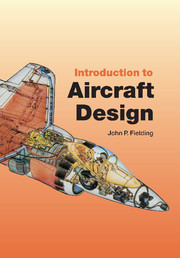Book contents
- Frontmatter
- Contents
- Preface
- Acknowledgements
- 1 Introduction
- 2 Why should we design a new aircraft?
- 3 Why is it that shape? – Civil aircraft
- 4 Why is it that shape? – Other types
- 5 What's under the skin? – Structure and propulsion
- 6 What's under the skin? – Airframe systems
- 7 What's under the skin? – Avionics, flight control and weapon systems
- 8 Why do aircraft cost so much?
- 9 What help can I get? – Bibliography and computer-aided design
- 10 The shape of things to come – Should the project continue?
- 11 What can go wrong? – Some lessons from past aircraft projects, and a glimpse into the future
- Appendix A Useful aircraft design data
- Appendix B A–90 parametric study. Example – the A-90 500-seat airliner
- Appendix C The prediction of aircraft reliability and maintainability targets
- References
- Index
7 - What's under the skin? – Avionics, flight control and weapon systems
- Frontmatter
- Contents
- Preface
- Acknowledgements
- 1 Introduction
- 2 Why should we design a new aircraft?
- 3 Why is it that shape? – Civil aircraft
- 4 Why is it that shape? – Other types
- 5 What's under the skin? – Structure and propulsion
- 6 What's under the skin? – Airframe systems
- 7 What's under the skin? – Avionics, flight control and weapon systems
- 8 Why do aircraft cost so much?
- 9 What help can I get? – Bibliography and computer-aided design
- 10 The shape of things to come – Should the project continue?
- 11 What can go wrong? – Some lessons from past aircraft projects, and a glimpse into the future
- Appendix A Useful aircraft design data
- Appendix B A–90 parametric study. Example – the A-90 500-seat airliner
- Appendix C The prediction of aircraft reliability and maintainability targets
- References
- Index
Summary
Avionic systems
Avionics is one of the most rapidly developing fields of aircraft design. Its importance and range has increased over recent years and as much as 40% of the cost of a new aircraft can be attributed to avionics. There is a bewildering range of avionic systems, each of which usually requires the use of many acronyms.
Figure 7.1 shows an avionics fit for a small executive aircraft. This aircraft is intended for flight with a crew of one or two pilots. If this aircraft had been in operation during the early post-war years, three additional crew-members would have been required, namely navigator, wireless operator and flight engineer. Modern efficient, reliable avionics have dramatically simplified these operations and have eliminated to need for these crew members.
The growth in the capabilities of military avionics has been even more dramatic and make it possible for pilots of single-seat aircraft to navigate, communicate, detect and attack targets at heights of 100 ft and speeds approaching the speed of sound. Figure 7.2 shows a schematic of such an avionic system whilst Fig. 7.3 shows the installation of components on the instrument panel.
Having looked at typical aircraft installations the next stage is to examine the functions of various types of avionic systems in the following major groups: communications, navigation systems, radar systems and others.
- Type
- Chapter
- Information
- Introduction to Aircraft Design , pp. 89 - 108Publisher: Cambridge University PressPrint publication year: 1999
- 1
- Cited by



